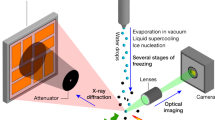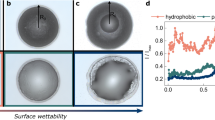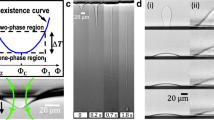Abstract
In an ensemble of volatile liquid drops, either in suspension or on a partially wetted substrate, large drops grow at the expense of smaller ones when the pressure is just above the saturated-vapour pressure. Below this critical pressure, all drops evaporate, with the smallest drops evaporating fastest. But an array of water drops of different sizes on a mica substrate cleaved in a vacuum behave differently: below the equilibrium vapour pressure, the largest drops evaporate fastest and the smallest ones more slowly. Here we show that this behaviour is related to the coexistence of thick and thin water films during evaporation.
This is a preview of subscription content, access via your institution
Access options
Subscribe to this journal
Receive 51 print issues and online access
$199.00 per year
only $3.90 per issue
Buy this article
- Purchase on Springer Link
- Instant access to full article PDF
Prices may be subject to local taxes which are calculated during checkout

Similar content being viewed by others
References
Cazabat, A.-M Contemp. Phys. 28, 347–364 (1987).
Brochard-Wyart, F. Soft Matter Physics 7–44 (Springer, Berlin, 1995).
Sharma, A. & Jameel, A. J. Colloid Interface Sci. 161, 190–208 (1993).
Samid-Merzel, N., Lipson, S. G. & Tanhauser, D. S. Phys. Rev. E 57, 2906–2913 (1998).
de Gennes, P. G. Rev. Mod. Phys. 57, 325–359 (1985).
Israelachvili, J. Intermolecular and Surface Forces 2nd edn (Academic, San Diego, 1992).
Ben-Jacob, E. Nature 343, 523–530 (1990).
Ihle, T. & Muller Krumbhaar, H. Phys. Rev. Lett. 70, 3083–3086 (1993).
McHale, G., Rowan, S. M., Newton, M. I. & Banerjee, M. K. J. Phys. Chem. B 102, 1964–1967 (1998).
Schafle, C., Bechinger, C., Rinn, B., David, C. & Leider, P. Phys. Rev. Lett. 83, 5302–5305 (1999).
Elbaum, M. & Lipson, S. G. Phys. Rev. Lett. 72, 3562–3565 (1994).
Sharma, A. Langmuir 9, 3580–3586 (1993).
Author information
Authors and Affiliations
Corresponding author
Ethics declarations
Competing interests
The authors declare no competing financial interests.
Rights and permissions
About this article
Cite this article
Leizerson, I., Lipson, S. & Lyushnin, A. When larger drops evaporate faster. Nature 422, 395–396 (2003). https://doi.org/10.1038/422395b
Issue Date:
DOI: https://doi.org/10.1038/422395b
This article is cited by
-
Formation of BI- and Polymodal Distributions and the Non-Ostwald Behavior of Disperse Systems
Journal of Engineering Physics and Thermophysics (2019)
-
The relation of steady evaporating drops fed by an influx and freely evaporating drops
Journal of Engineering Mathematics (2012)
Comments
By submitting a comment you agree to abide by our Terms and Community Guidelines. If you find something abusive or that does not comply with our terms or guidelines please flag it as inappropriate.



